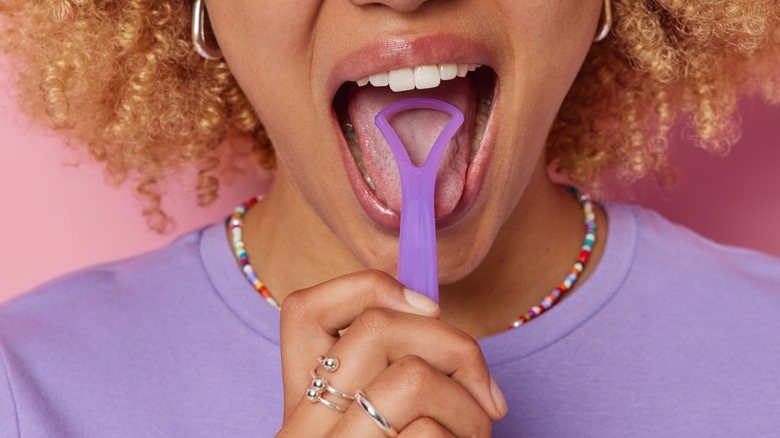The Proper Way To Clean Your Tongue For Fresh Breath
Despite the combined efforts of brushing and flossing, bad breath can still permeate these lines of defense. The culprit? Your tongue. Experts at Dolfield Dental explain that the small bumps along the surface of our tongue are called papillae. While we can thank papillae for the role they play in our sense of taste (via WebMD), they also create an environment in which food debris can easily become stuck between the bumps. This can lead to an accumulation of bacteria and subsequent stinky breath. Excessive bacterial growth may also cause tongue discoloration, often in the form of a white coating. In severe instances of bacterial buildup, the tongue may develop a black or brown hairy texture, explains dental expert Jack Hirschfeld to PopSugar.
Regularly cleaning our tongues can help protect against bacterial overgrowth and restore fresh breath. To do so, New York-based dentist Dr. Vera Tang tells Self that individuals can choose between two options: a toothbrush or a tongue scraper. Because a toothbrush may evoke a gag reflex in some people, Dr. Tang suggests that the flattened shape of a tongue scraper may be a better fit in such cases. If you opt to use a toothbrush, however, no need to invest in a new one. Your everyday toothbrush is fine to use on both your tongue and teeth since they're exposed to much of the same bacteria.
Start from back to front
To begin, extend your tongue out as far as is comfortable (via Self). Place the tool at the back of your tongue and lightly scrape forward all the way down to the tip. Don't be too quick to repeat, however! Dr. Tang explains that you'll want to rinse the apparatus with water each time before beginning again. This way, you protect against recontaminating the area. If you're struggling with a gag reflex, Dr. Tang suggests distracting yourself, such as by humming. Alternatively, experts at Dolfield Dental advise beginning your first tongue cleaning in the middle of the tongue and gradually starting further back once you've gotten more familiar with the practice. Once done, rinse your toothbrush or tongue scraper off with water until it's clean of any visible debris.
Dental experts at Dr. Emma Wu & Associates suggest cleaning your tongue twice daily following your routine brushing. Even better, doing so before bed can be particularly helpful in preventing bad breath come morning. Finally, remember to discard your toothbrush or tongue scraper every three or four months and replace it with a fresh one (via Self).


